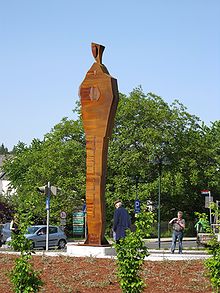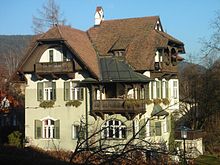Anton Bulfon
Anton Bulfon (born June 13, 1885 in Tiffen , † October 27, 1961 in Klagenfurt ) was an Austrian builder. At that time he was considered the largest building contractor in Carinthia . He refused to build unsightly buildings and was an early proponent of having his employees share in success. Regardless of the possible consequences, he is said to have strictly refused to cooperate with the National Socialists. In 2008 a memorial was erected for him at the entrance to Velden am Wörthersee .
biography
Origin and youth
As was customary at the time, the best bricklayers, stonecutters and road builders came from Friuli , which until 1866 belonged to the Austrian Empire . Anton Bulfon's father, master bricklayer Albin Bulfon (1855–1943), moved from Ovedasso to Tiffen near Feldkirchen in Carinthia as a very young man . There he founded a flourishing construction company and acquired considerable properties in Feldkirchen, St. Veit an der Glan and Velden am Wörthersee (here from the Dietrichstein lordship ). He later left the grounds in Velden to his son Anton.
As a 17-year-old Anton Bulfon was assigned by his father to be the site manager of the large elementary school in Techelsberg . In order to gain respect from his workers at the time and not look so young, he grew a full beard, which later earned him the nickname "the beard". He earned respect from the many employees in his company and from everyone who had anything to do with him, but above all through his competence.
Starting a family
At the age of 24 he was the youngest builder in Austria. In 1908 he moved to Velden, married in 1911 and brought his young wife Lisi Köber into the self-built "Villa Lisi" in today's Koschatpromenade. His tireless diligence and ambition made it possible for him to set up a considerable construction company and to ensure the continued existence of his family with four sons and three daughters.
His eldest brother Albin, who had taken over the company in Feldkirchen, died in Russia during the First World War . His brother Hans, who had taken over the grounds in St. Veit, died in the 1930s, and brother Josef was chronically ill. This meant that builder Anton Bulfon not only had to look after his own seven children, but also the families of his brothers. The lunch table was often very large and included up to 28 people.
Master builder Bulfon was an early riser and loved being on site before the first bricklayer. From the start, the construction office was housed in the half-basement of Villa Lisi, where Mr. Otto Moro meticulously mastered the entire payroll and bookkeeping. At the same time, the Viennese architect Franz Baumgartner was a teacher at the building school in Villach. It became famous much later with the so-called Wörthersee architecture. This imaginative and creative man, however, had no talent for the practical or business. His friend master builder Anton Bulfon therefore took over the construction work for almost all buildings in Velden and around the Wörthersee. He acquired customers for Baumgartner, negotiated the contracts and corrected the plans in technical and financial terms. To put it musically: if the architect Baumgartner was the composer, then the architect Bulfon was the interpreter who performed the work.
The start of the joint success was the construction of the forest lake power plant in Saag, for which the builder offered the most technically feasible and, above all, the cheapest variant and was awarded the contract. In addition to countless buildings together with Baumgartner, he was the long-term construction officer of the Bleiberger Bergwerksunion (BBU ). He built the mining factory houses near Raibl (today Cave di Predil / Italy), in Prevalje (today Slovenia), the factory settlements in Arnoldstein and factory halls and apartments in Gailitz. His work also included the construction of the Packer federal road from Carinthia to Styria and the uniquely difficult road into the Lesachtal. During the First World War he built the spectacular pass road over the Vrsic under unbelievably harsh conditions (avalanches, enemy fire, cold, hunger); this road from Kronau (today Kranjska Gora) to Tolmein (today Tolmin) was the only supply possibility for the Austrian troops on the Insonzo Front (today Slovenia) during the First World War. Bulfon also built the well sockets and drinking water pipeline from Penken to Velden. It was thanks to his special negotiating skills that the casino came to Velden. Against the resistance of the local council, after initial skepticism, he finally succeeded in moving the beach café on the lake to a location in Pörtschach, where intensive efforts had also been made.
Achievements
Bulfon brought the Strandhotel Bulfon into being with the lido designed by Baumgartner and completely renovated the outdated Hotel Ulbing. He also built the Hotel Carinthia - at that time the most elegant and modern hotel in Velden. With the help of his wife, he also ran these businesses. He successfully ran a ski manufacturing company with master carpenter Josef Fantur.
During the construction of the Hotel Excelsior (Hecht family) he lost a fortune due to inflation , but he never gave up and skilfully held the reins until his end.
Master builder Bulfon had many of the fields he inherited in Velden parceled out and sold them to his workforce at a very affordable price. It was one of his goals that each of his bricklayers should own a house and each of his site managers a villa.
Anton Bulfon died on October 27, 1961 in Klagenfurt.
On May 27, 2008, his work was honored with the erection of a monument at the entrance to the center of Velden.
When the monument was unveiled by church dignitaries, the governor of Carinthia and the mayor of Velden, two factors in particular were highlighted in his work.
His credo was to build only elegant buildings, as future generations would still have to live with them, and his responsible approach to employees. Despite a lack of orders, he did not lay off any workers during the great economic crisis. In this way he spared many families in the region the lot of unemployment.
The site of the monument was renamed "Bulfon Park". It is located on the property that was once given to him by his father when he started in Velden.
| personal data | |
|---|---|
| SURNAME | Bulfon, Anton |
| BRIEF DESCRIPTION | Austrian builder |
| DATE OF BIRTH | June 13, 1885 |
| PLACE OF BIRTH | Tiffen |
| DATE OF DEATH | October 27, 1961 |
| Place of death | Klagenfurt am Wörthersee |

